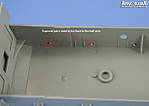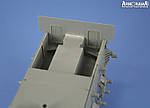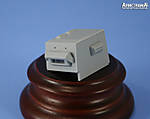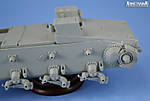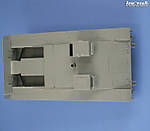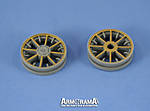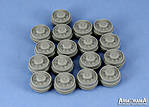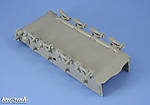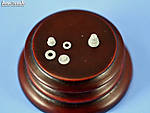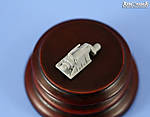1⁄35Maximum Firepower: DML's
16
Comments

Introduction
The “Dicker Max” was conceived and designed to fill the role of a bunker buster heavy assault gun by mounting the K18 10.5cm cannon on the foundation of a modified Pzkpfw IV Ausf D chassis. Two vehicles were produced and sent to the Eastern Front in 1941 where they served with the Pz.Jg.Abt. 521 with distinction. One vehicle was destroyed by overheating that ignited its ready ammunition and the other was sent back to Juterbog for refit in 1942, returned to the field, and eventually lost in combat. This build focuses on DML’s kit #6357 as a primarily out of the box effort with markings appropriate for one of the vehicles in service in 1941.Lower Hull and Suspension
The kit shows its heritage going back to the Pzkpfw IV B-E line of “Super Kits” in the design and construction of the suspension assemblies. The construction is accomplished as a serious of detailed and repetitive sub-assemblies that, with some care when gluing, produce a workable suspension. All the road wheel and return roller halves were assembled as directed and the separate road wheel rubber rims left off for painting as the friction fit tolerances are too tight to allow for paint beforehand without splitting the rims during installation. I used the slide-molded one-piece option for the idlers which included PE inserts, and the interior surfaces required some clean up but still provided more detail than the traditional 2-piece idlers also provided. The kit also provided options for either the early style single bolt hubs or the later style 7 bolt hubs as full sets and the earlier style were selected to go with the 1941 finish. The multi-part idler mounts were assembled and installed with the mount arms left loose to allow for the idler to be adjusted later with the track installation for proper tensioning. The idler arm is “keyed” with the slot on the mount to allow it to be adjusted to different tension levels, a nice touch whether using the kit supplied individual links or an after-market set. The lower hull assembly is straight forward with the hull tub combining with the front and rear plates along with the installation of the armored suspension covers on the lower hull bottom. The suspension bogies were installed minus the road wheels into their appropriate locations, which are a tight snap-fit requiring just a little bit of liquid glue to secure in place. The bogies have a pin that protrudes into the hull interior, some of which need to be cut flush in later steps to facilitate installation of the fighting compartment interior, easily accomplished with sprue cutters and sanded flush. The front plate also includes the installation of the tow pintles and care has to be taken to install them on the correct sides and angled inward, as the instructions provide diagrams showing the kit’s right and left top view, not the builder’s. The foundation of the fighting compartment installs inside the hull tub along with two side panels using a post mount to align it with the hull tub. The side panels have two PE strips installed to make up the slide mounts for the main ammunition locker door and I kept the side panels separate from the tub for installation after test fitting first. The panels have a slot fit into the rear hull plate and I elected to install them after the tub was in place to insure they fit properly. A small gap where the tub met with the hull plate, likely introduced when I installed the rear plate to the hull bottom, required some minor putty and sanding to correct.Upper Hull and Fenders
In order to make sure that the upper hull and superstructure would align properly in later steps, I assembled the driver’s hood separately as directed. The hood plates have nicely molded weld seam detail and liquid glue was used to fuse the plates together and preserve this. The glacis plate also has a storage box with a dummy visor installed which has shallow locator marks, requiring some care to place it straight and in the correct position. The next process dealt with the glacis plate which must mate up with the hull front, sides and the interior compartment tub in order to be in the correct position to facilitate installation of the fenders and the fighting compartment superstructure. To this end, I dry fit the glacis plate to check the alignment and glued in place using finger pressure and liquid glue on both sides to get a good join. The installation of the driver’s hood produced a small gap between the lower edge of the hood and the hull side, but I don’t consider this an issue since the fender slots into the small notch at the rear of the hood and rests on a small ledge, covering the gap in the process. Both fenders were installed, taking care to get them lined up properly front and back although later on I discovered they had drooped slightly at the outer edges when it came time to mate them up with the superstructure, the fit overall was still good. I installed the fire extinguisher, fender bracket, siren, headlamp, and rear blackout light on the right fender and the bracket, headlamp, and jack on the left side. The rear blackout lamp has the flap raised in the non-blackout position for a little variety from the norm of the plate in the lowered position. Due to the drooping issue, the right side bracket and jack were removed and reinstalled in later steps prior to painting.Comments
Bill
Great job and thanks for the report. Went out and bought one for myself.
Can't wait to put it together.
SEP 05, 2007 - 07:48 AM
Hi Bill,
Excellent build, the finish is tops. Tis a shame the vehicle never caught on as its got great lines ........
cheers
Brent
SEP 05, 2007 - 01:55 PM
Hi Bill,
You really did a good job on the "Dicker Max" there.
The only thing that is off a bit is the story about the K.Pz.Sfl. IVa.
It was originally developed in 1939 by Krupp in the Grusonwerke in Magdeburg. The demands from the Wehrmacht where to design a vehicle with enough firepower to be able to destroy bunkers and penetrate armour (under a 30 degree angle) at long ranges (over 2 km's).
Krupp started to design two different vehicles, both based on the PzKpfW-IVA. The first would be equipped with the 10.5 cm schwere Feldhaubitze K 18 L/52 (which was conveniently produced by their neighbours) and the other with a 12.8 cm gun.
Because the 10.5 cm gun was produced next door and it was easier to install, Krupp settled for the K-18.
Eventually 2 vehicles where produced as prototypes (even though Hitler wanted to start serial production right away) and where sent to the 521st Panzerjäger Detachment for a proposed attack on Gibraltar. When this never eventuated, they were transferred to the 3rd Panzer Division and saw combat on the Eastern Front in 1941.
Eventually one prototype was captured by the Russians after it got hit. The hit caused a fire, resulting in the ammo to ignite rendering the vehicle useless.
The second vehicle was then sent back to the Grusonwerke in Magdeburg to be refitted as a normal PzKpfW-IV.
The serial production of the "Dicker-Max" never started because the Germans decided to build the Nashorn instead. That vehicle could be produced a lot faster, but also packed less of a punch. Looking in hindsight, serial-production of the "Dicker-Max" could have proven to be more useful since it's 10.5 cm gun would even have been lethal for the later JS-2 tanks.
Greetz Recce
OCT 25, 2007 - 07:04 AM
Recce,
Thanks for the additional information on the history of the Max.
Kevin,
Thanks as well for your comments.
OCT 25, 2007 - 09:25 AM
Copyright ©2021 by Bill Plunk. Images and/or videos also by copyright holder unless otherwise noted. The views and opinions expressed herein are solely the views and opinions of the authors and/or contributors to this Web site and do not necessarily represent the views and/or opinions of Armorama, KitMaker Network, or Silver Star Enterrpises. All rights reserved. Originally published on: 2007-05-20 00:00:00. Unique Reads: 38300





